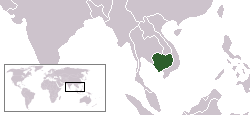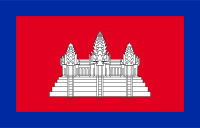Japanese occupation of Cambodia
| Kingdom of Cambodia | |||||||||
|---|---|---|---|---|---|---|---|---|---|
| 1941–1945 | |||||||||
 | |||||||||
| Status |
Protectorate of Vichy France under Japanese military control (1941–1945) Constituent territory of French Indochina (1941–1945) Client state of Japan (1945) | ||||||||
| Capital | Phnom Penh | ||||||||
| Government | Client state | ||||||||
| King | |||||||||
• 1941-1945 | Norodom Sihanouk | ||||||||
| Historical era | World War II | ||||||||
• Established | 1941 | ||||||||
• Japanese invades French occupied Cambodia | August 1941 | ||||||||
• Coup de force | February 1945 | ||||||||
| 15 August 1945 | |||||||||
• Reestablishment of French authority in Cambodia |
October 1945 | ||||||||
• Disestablished | 1945 | ||||||||
| Currency | Cambodian riel | ||||||||
| ISO 3166 code | KH | ||||||||
| |||||||||
| Today part of |
| ||||||||
Part of a series on the |
|---|
| History of Cambodia |
| Early history |
| Dark ages |
| Colonial period |
| Contemporary era |
| Timeline |
|
|
The Japanese occupation of Cambodia was the period of Cambodian history during World War II when the Kingdom of Cambodia was occupied by the Japanese. The Vichy French, who were a client state of Nazi Germany, nominally maintained a French protectorate over Cambodia and other parts of Indochina during most of the Japanese occupation.
The liberation of Paris occurred in the late summer of 1944, and in early 1945 a Japanese coup d'état in French Indochina caused Cambodia to officially separate from newly liberated France. Cambodia declared itself an independent nation, and the Japanese military presence continued for the brief remainder of the war.
The Japanese occupation in Cambodia lasted from 1941 to 1945 and, in general, the Cambodian population escaped the brutalities inflicted on civilians by the Japanese occupiers in other countries of Southeast Asia. After the nominal French Indochina colonial government was overthrown in 1945, Cambodia became a pro-Tokyo puppet state until the surrender of Japan.[1]
Historical background
The 1940–41 Franco-Thai War left the French Indochinese colonial authorities in a position of weakness. The Vichy government signed an agreement with Japan to allow the Japanese military transit through French Indochina and to station troops in Northern Vietnam up to a limit of 25,000 men.[2]
Meanwhile, the Thai government, under the pro-Japanese leadership of Field Marshal Plaek Phibunsongkhram, and strengthened by virtue of its treaty of friendship with Japan, took advantage of the weakened position of France, and invaded Cambodia's western provinces to which it had historic claims. Following this invasion, Tokyo hosted the signature of a treaty in March 1941 that formally compelled the French to relinquish the provinces of Battambang, Siem Reap, Koh Kong as well as a narrow extension of land between the 15th parallel and the Dangrek Mountains[3] in Stung Treng Province.
As a result, Cambodia had lost almost half a million citizens and one-third of its former surface area to Thailand.[4]
Japanese occupation
In August 1941, the Imperial Japanese Army entered the French protectorate of Cambodia and established a garrison that numbered 8,000 troops. Despite their military presence, the Japanese authorities allowed Vichy French colonial officials to remain at their administrative posts.
On 20 July 1942, there was a major anti-French demonstration in Phnom Penh after a prominent monk, Hem Chieu, was arrested for allegedly preaching seditious sermons to the colonial militia. The French authorities arrested the demonstration's leader, Pach Chhoeun, and exiled him to the prison island of Con Son.[1] Pach Chhoen was a respected Cambodian intellectual, associated with the Buddhist Institute and founder of Nagaravatta, the first overtly political newspaper in the Khmer language in 1936, along with Sim Var.[5] Another of the men behind Nagaravatta, Son Ngoc Thanh (a Paris-educated magistrate) was also blamed for the demonstration, which the French authorities suspected had been carried out with Japanese encouragement.
Collaborationist Kingdom of Kampuchea
In 1945, in the closing stages of World War II, Japan made a coup de force that temporarily eliminated French control over Indochina. The French colonial administrators were relieved of their positions, and French military forces were ordered to disarm. The aim was to revive the flagging support of local populations for Tokyo's war effort by encouraging indigenous rulers to proclaim independence.
On 9 March 1945, young king Norodom Sihanouk proclaimed an independent Kingdom of Kampuchea, following a formal request by the Japanese. Shortly thereafter the Japanese government nominally ratified the independence of Cambodia and established a consulate in Phnom Penh.[6] On 13 March, king Sihanouk changed the official name of the country in French from Cambodge to Kampuchea. The new government did away with the romanisation of the Khmer language that the French colonial administration was beginning to enforce and officially reinstated the Khmer script. This measure taken by the short-lived governmental authority would be popular and long-lasting, for since then no government in Cambodia has tried to romanise the Khmer language again.[7]
Son Ngoc Thanh returned to Cambodia in May. He was initially appointed foreign minister and would become Prime Minister two months later.[8] The Cambodian puppet state of Japan lasted from March to October 1945.
The Japanese occupation of Cambodia ended with the official surrender of Japan in August 1945. After Allied military units entered Cambodia, the Japanese military forces present in the country were disarmed and repatriated. The French were able to reimpose the colonial administration in Phnom Penh in October the same year. After arresting Son Ngoc Thanh for collaboration with the Japanese, the French colonial authorities exiled him to France, where he lived under house arrest. Some of his supporters went underground and escaped to Thai-controlled northwestern Cambodia, where they were eventually to join forces in a pro-independence group, the Khmer Issarak. This anti-French, politically heterogeneous nationalist movement was organised with Thai backing, but would later split into factions.[9]
See also
References
- 1 2 Milton Osborne, Sihanouk, Prince of Light, Prince of Darkness. Silkworm 1994
- ↑ Jean-Philippe Liardet, L'Indochine française pendant la Seconde Guerre mondiale; Les accords de septembre 1940 Archived 5 February 2012 at the Wayback Machine.
- ↑ Jean-Philippe Liardet, L'Indochine française pendant la Seconde Guerre mondiale; La guerre contre le Siam, 1940-41 Archived 30 June 2009 at the Wayback Machine.
- ↑ Cambodia, The Japanese Occupation, 1941-45
- ↑ Ian Harris, Buddhism and politics in twentieth-century Asia
- ↑ Keat Gin Ooi Southeast Asia: a historical encyclopedia
- ↑ David P. Chandler, A History of Cambodia, Silkworm 1993
- ↑ Cambodia, The Emergence of Nationalism
- ↑ Cambodia, Appendix B - Major Political and Military Organizations

.svg.png)